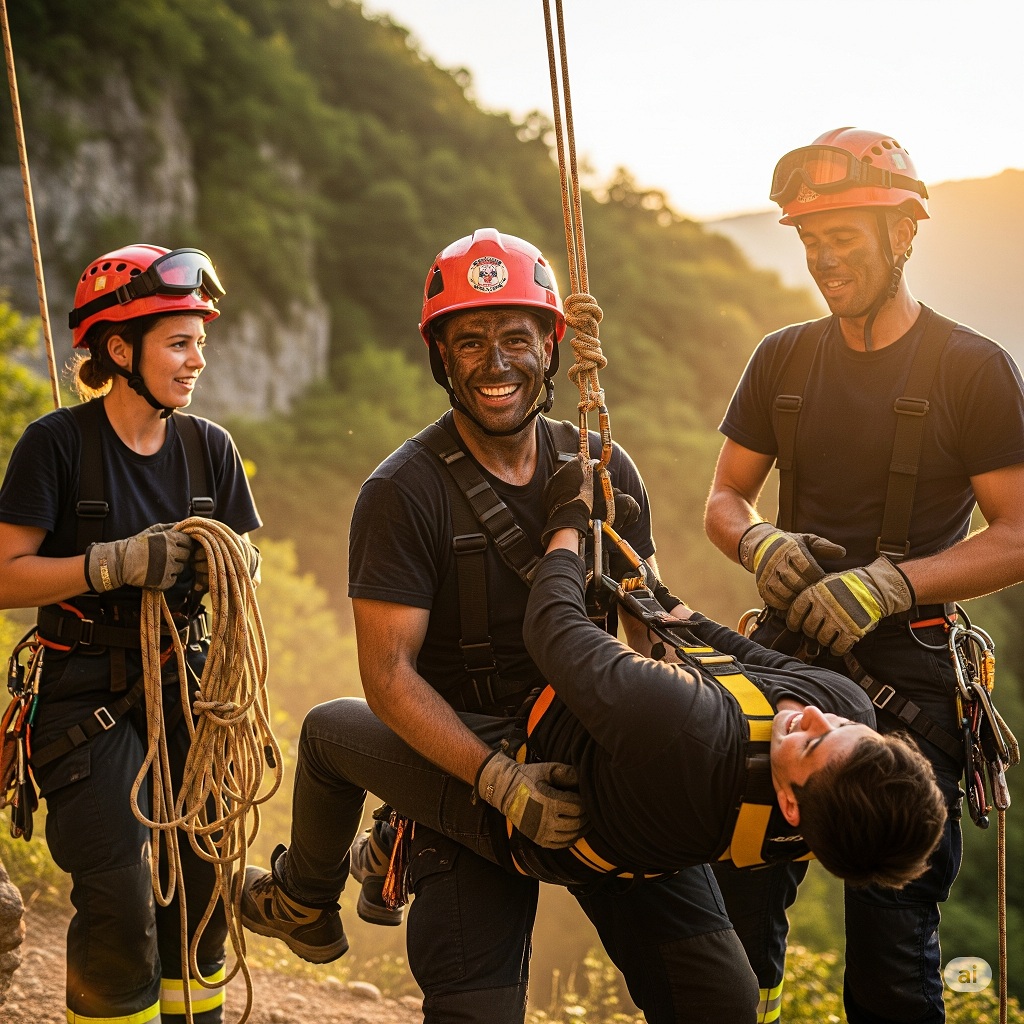
As someone who has witnessed the critical role of rope rescue in firefighting firsthand, I can attest to the importance of this specialized skill. When flames rage and lives hang in the balance, the ability to execute a successful rope rescue can make all the difference. In this article, I’ll delve into the intricacies of rope rescue in fire scenarios, exploring the techniques, equipment, and training required to perform these high-stakes operations.
Rope rescue is a cornerstone of firefighting that demands precision, strength, and quick thinking. From rappelling down burning buildings to extracting individuals from precarious situations, firefighters trained in rope rescue are true heroes in action. Join me as I uncover the challenges and rewards of mastering this essential aspect of firefighting, shedding light on the vital role it plays in saving lives and protecting communities.
The rewards of rope rescue in firefighting are immense and deeply satisfying. Beyond the technical skills and rigorous training involved, the true rewards lie in:
- Saving Lives: The most profound reward is directly contributing to saving someone in a precarious situation, whether from a collapsed building, a confined space, or a high-angle environment.
- Teamwork and Trust: Rope rescue operations demand seamless coordination and absolute trust among team members. Successfully executing such a complex task strengthens bonds and fosters deep camaraderie.
- Skill Mastery and Confidence: The specialized nature of rope rescue means firefighters constantly hone their skills, leading to a strong sense of personal and professional mastery and increased confidence in challenging situations.
- Community Impact: Knowing that you possess the skills to respond to highly technical emergencies and protect your community from diverse threats is a significant source of pride.
- Problem-Solving: Each rescue scenario presents unique challenges, requiring quick thinking, adaptability, and innovative problem-solving, which are intellectually stimulating rewards.
Importance of Rope Rescue in Firefighting
When it comes to firefighting, rope rescue plays a crucial role in saving lives and ensuring the safety of both civilians and firefighters. As a firefighter, I understand the significance of being skilled in rope rescue techniques to navigate challenging environments and reach individuals in distress.
- Rope rescue allows firefighters to access difficult-to-reach areas in buildings or natural landscapes.
- It provides a vital lifeline for individuals trapped in precarious situations during fires or other emergencies.
- Firefighters trained in rope rescue are equipped to perform swift and efficient rescues when time is of the essence.
In high-stakes operations, such as building collapses or mountain rescues, the ability to execute successful rope rescues can make a critical difference in saving lives. Therefore, as a firefighter, I continuously hone my rope rescue skills to be prepared for any situation where this specialized technique is required.
Techniques for Rope Rescue in Fire Scenarios
In fire scenarios, mastering rope rescue techniques is crucial for firefighters like me. Here are some key methods we employ:
- Anchor Systems: Setting up secure anchor points is the foundation of any rope rescue operation. Without strong anchors, the entire rescue effort could be compromised.
- Belays and Safety Lines: Using belays and safety lines ensures that both the rescuer and the victim are protected throughout the operation.
- Rope Ascending and Descending: Knowing how to ascend and descend ropes swiftly and safely is essential in navigating different levels during a rescue.
- Knot Tying: Proficiency in tying various knots is fundamental for creating rigging systems that support the weight of individuals during rescues.
- Rope Management: Proper rope management techniques help prevent tangles and ensure efficient deployment and retrieval of ropes during operations.
- Patient Packaging: Securing and packaging the rescued individual appropriately is vital to ensure their safety during the evacuation process.
By honing these skills, firefighters enhance their ability to conduct successful rope rescues in challenging fire scenarios.
Essential Equipment for Rope Rescue Operations
Whether I’m responding to a high-rise building fire or a remote wilderness rescue, having the right equipment is crucial for successful rope rescue operations. Below are some essential tools that I always make sure to have on hand:
- Rope: An obvious necessity, having a static rope with a suitable length and strength is fundamental for setting up anchor systems and performing rescues.
- Carabiners and Pulleys: These tools help in creating mechanical advantages, reducing the amount of effort needed in hauling systems during a rescue operation.
- Harness: A properly fitting climbing harness is essential for securing myself and maintaining safety during high-angle rescues.
- Helmet: Protecting my head from falling debris or accidental impacts is vital, making a high-quality helmet a non-negotiable part of my gear.
- Ascenders and Descenders: These tools allow me to move up and down ropes efficiently and safely, enabling me to navigate challenging vertical terrains.
- Prusik Cord: A versatile tool that can be used for ascending, descending, self-rescue, and creating friction hitches in hauling systems.
- Anchor Devices: Having reliable anchor devices such as cams, nuts, or bolts is crucial for setting up secure anchor systems in various environments.
- Rescue Rope Bag: Keeping all my gear organized and easily accessible in a rescue rope bag ensures efficiency during high-stress rescue scenarios.
By ensuring I have the right equipment at my disposal, I can confidently tackle any rope rescue operation that comes my way, knowing that I am well-prepared to handle the challenges of the task at hand.
Training Requirements for Rope Rescue in Firefighting
When it comes to rope rescue in firefighting, training is crucial to ensure that firefighters are equipped with the necessary skills and knowledge to handle challenging rescue scenarios effectively. Here are some key training requirements for rope rescue in firefighting:
- Technical Rope Rescue Training: Proper training in technical rope rescue techniques is essential to ensure that firefighters understand how to set up systems, perform rope maneuvers, and execute rescues safely and efficiently.
- Knot Tying Skills: Mastery of various knots is a fundamental skill for firefighters involved in rope rescue operations. Knot tying skills are crucial for creating secure anchor points and constructing reliable rescue systems.
- Mock Scenarios: Conducting regular mock rescue scenarios allows firefighters to practice their skills in a simulated high-stress environment. These exercises help build confidence, improve teamwork, and identify areas for improvement.
- Equipment Familiarity: Firefighters must undergo training to become proficient in the use of rope rescue equipment such as harnesses, carabiners, pulleys, descenders, and ascenders. Knowing how to properly use and maintain this equipment is essential for safe and effective rescue operations.
- Risk Assessment: Training in risk assessment is key to evaluating the hazards present in a rope rescue situation and making informed decisions to protect the safety of both rescuers and victims.
Comprehensive training in rope rescue techniques, knot tying skills, mock scenarios, equipment familiarity, and risk assessment is essential for firefighters to be prepared for any rope rescue situation they may encounter in the line of duty.
Challenges and Rewards of Mastering Rope Rescue
Mastering rope rescue in firefighting comes with a unique set of challenges and rewards that shape the capabilities of a firefighter. The demanding nature of rope rescue operations requires continuous training and skill development to navigate various obstacles effectively. Here are some key points to consider:
- Challenges:
- Heightened Risks: Rope rescue often involves working at great heights, exposing firefighters to increased danger and complexity.
- Time Sensitivity: Rescue operations must be executed swiftly and efficiently to ensure the safety of individuals in distress.
- Physical Demands: Maneuvering ropes, harnesses, and equipment requires strength, endurance, and agility in demanding environments.
- Rewards:
- Impactful Rescues: Successfully executing a rope rescue operation can save lives and make a lasting difference in individuals’ outcomes.
- Skill Mastery: Mastering rope rescue techniques enhances a firefighter’s expertise and confidence in handling challenging scenarios.
- Team Collaboration: Rope rescue operations foster teamwork and communication among firefighters, strengthening cohesion and effectiveness.
Engaging with the challenges and rewards of mastering rope rescue is a pivotal aspect of a firefighter’s training and expertise. By honing these skills, firefighters are better equipped to handle complex rescue missions and ensure the safety of both rescuers and individuals in need.
Conclusion
Mastering rope rescue in firefighting is a challenging yet rewarding endeavor. The demanding nature of rope rescue operations presents heightened risks and requires quick thinking and physical prowess. Successfully executing rope rescues not only saves lives but also enhances skill mastery and fosters teamwork among firefighters. By embracing these challenges head-on, firefighters can navigate obstacles effectively, ensuring safety in high-stress environments. It’s crucial for firefighters to stay prepared, hone their skills, and work together seamlessly to tackle any rope rescue mission that comes their way.
Frequently Asked Questions
What are some challenges associated with mastering rope rescue in firefighting?
Mastering rope rescue in firefighting presents challenges like heightened risks, time sensitivity, and physical demands. Firefighters must be well-prepared to handle these obstacles effectively.
What are the rewards of mastering rope rescue in firefighting?
Successfully mastering rope rescue can have significant impacts, enhance skill mastery, and promote team collaboration among firefighters. It is a rewarding experience that contributes to saving lives and ensuring safety in high-stress environments.
